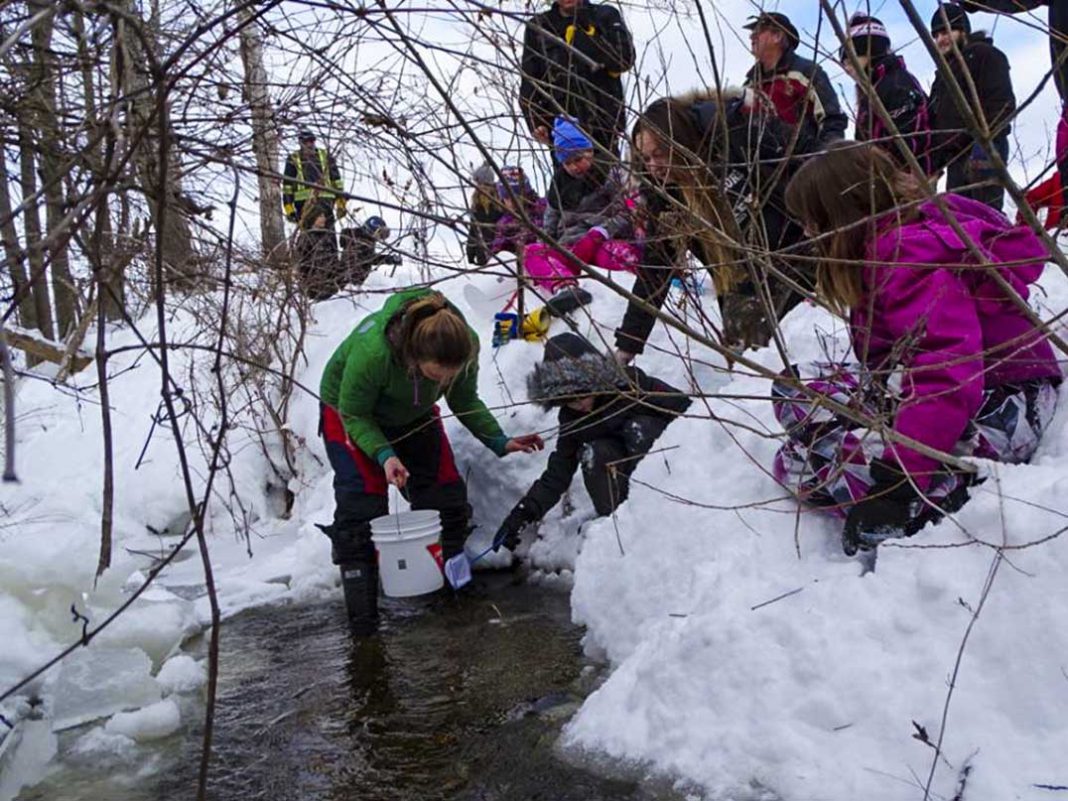SHEGUIANDAH – Little Current Public School (LCPS) students saw the fruits of their labour released into nature late last month as the Grade 4 class’s brook trout fry, reared successfully in the classroom’s microhatchery, found a new home in a Sheguiandah First Nation creek.
After 9,000 brook trout eggs were dropped off to the students and following some final instructions, the students were left in charge of their brand-new microhatchery. They monitored the dissolved oxygen, pH levels and temperature of the water; they tried to remove any dead eggs from the bell jar with the pipette and they watched the eggs to make sure the water was circulating through the bell jar, keeping the eggs moving and well oxygenated.
The eggs started to hatch on January 7. Once hatched, the brook trout fry would swim or float to the top of the bell jar and flow into the aquarium. It took a couple days for all the eggs to hatch. The ones that didn’t hatch and turned white were removed from the system so they wouldn’t infect the surviving fry. Once all the fry made it into the aquarium the students watched their development and continued to monitor water quality.
At this stage in the fry’s development the students had to monitor the size of the egg sac (the orange bulge hanging below their belly). When the fry hatched and moved into the aquarium they were getting all the nutrients and sustenance they needed from this egg sac. Once the egg sac disappeared, the students knew it was time to either start feeding the fish or move them into a local creek.
“Ultimately, we wanted to move the fry into a creek before their egg sac disappeared to ensure they could adjust to their new surroundings with some nutrients left in their egg sac,” said Maria Diebolt of Manitoulin Streams. “It’s also best to move the fry earlier, rather than later, to reduce the risk of a large die-off in the hatchery. The longer they’re kept in the hatchery the more chances there is for bacteria and disease to start and spread.”
On February 26, it was decided that the fry needed to be released into the wild as soon as possible and the release date was planned for Friday, March 1 at a Sheguiandah First Nation waterway.
Chief Andrew Aguonie co-ordinated the community’s public works department to clear the snow from an area near the creek with a trail down to the water’s edge to release the brook trout. On March 1, the students scooped the fry from their hatchery into buckets and took them on the bus and headed to Sheguiandah Creek. Once at the creek the students carried their fry down to the water’s edge. They placed the bucket in the water and added a bit of creek water to let the fry adapt to the temperature change. While they were giving the fry time to adapt, a small talk was given to the students and community volunteers about the importance of the project. Each student then scooped some fry out of the bucket and released them into the water. Some of the students’ comments included “bye little fishy,” “good luck in the future,” “see you later” and “grow big so I can catch you and eat you!” After all the students had a turn, the volunteers released some of the fry and then Chief Aguonie released the remaining fish into the creek.
The Grade 4 students laughed in the sunshine, climbed up huge mountains of snow only to slide back down, warmed up by the bonfire, ran down to the creek to look for their fish, felt how cold the water was and burnt off a lot energy.
“We finished the day off around the bonfire with Chief Andrew talking about the importance of the work the students were doing,” Ms. Diebolt said. “He then offered tobacco to the Creator and gave thanks. This was a great day for the students and volunteers who came out. We learned about the importance of our aquatic habitat and the impact humans can have, positive or negative. For the students, this project helped them develop a sense of environmental stewardship, brought awareness to potential career opportunities and showed them the importance of giving back to the community.”
Special thanks were given to the Little Current Fish and Game Club, Little Current Lions Club, Little Current Public School, Manitoulin Streams Improvement Association, Micro-Hatcheries Inc., Sheguiandah First Nation and TD Friends of the Environment Fund.



